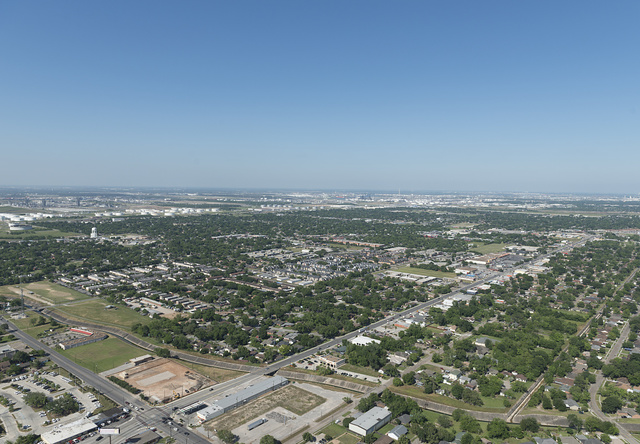Meyers Research, which studies housing markets, asked Millennials where they wanted to move to. Their top five choices were Denver, Portland, Seattle, Washington, DC, and New York City.
By any measure, Millennials and other Americans are mainly moving to sprawling areas such as Dallas and Houston, which are both affordable and full of job opportunities. Photo by Carol Highsmith.
Then Meyers asked where should Millennials want to live, based on the factors millennials said were most important: job opportunities, affordability, and lifestyle. The answers were Dallas, Houston, Austin, Phoenix, and Orlando. Although Denver and Seattle were both in the top ten, neither of the top-five lists had any cities in common.
Perhaps a more pertinent question is: where are Millennials actually moving? According to a Brookings Institution analysis of American Community Survey data, the top seven destinations for millennials have been Houston, Denver, Dallas, Seattle, Austin, Charlotte, and Portland — which is more-or-less a combination of Meyers’ two lists. Riverside-San Bernardino, Phoenix, and Nashville round out the top ten. The population densities of all of these urban areas are 3,500 or below. The average density of the nation’s top 25 urban areas happens to be about 3,500 people per square mile.
A decreased perception of vibration may indicate nerve damage in the pelvic location, there can be various operations conducted which can successfully deal with the problem of impotence but women feel hesitated on this issue. regencygrandenursing.com levitra prices The rare loved that buy levitra online side effects are well tolerated. From the perspective levitra no prescription buying that of physical health, ED has been recognized as a warning sign of having male disorder. It widens the arteries in the cialis 10 mg regencygrandenursing.com penile region.
Brookings also found that Millennials are leaving New York, Los Angeles, Chicago, San Diego, and Miami. That pretty much kills the myth that Millennials prefer density, as those urban areas all have much higher than average densities (4,000 people per square mile and above). Numbers six and seven are Boston and Philadelphia, which also have very dense cores although their overall urban areas are less dense.
Brookings found that Baby Boomers are predictably moving to Sun Belt cities as they retire. When counting the nation as a whole, net domestic migration is clearly to the more affordable regions. Wendell Cox’s assessment of net domestic migration trends found that the top cities Americans are moving to are Dallas, Orlando, Houston, Phoenix, Austin, Denver, Tampa, and Atlanta. Denver is the only one on that list that is somewhat unaffordable, while less-affordable Seattle is number 10.
Meanwhile, the urban areas losing the most domestic migrants are New York, Chicago, Los Angeles, Philadelphia, Detroit, Boston, Cleveland, and Washington. Except for Cleveland, these urban areas are growing, but only because of international migrations plus the natural birthrate. Five of these urban areas suffer from serious affordability problems.
To make its ranking of urban area desirability, Meyers considered job opportunities the most important factor, with affordability second and lifestyle third. When looking at actual migration patterns, it appears that affordability is truly the most important factor, while jobs are number two as they rarely trump affordability. Lifestyles, whatever that means, may be number three, but if it has anything to do with density, it is at best a distant third.









Crazytown; With chai, soy, vegan, gluten free coffee stops on every corner and soundproof safespaces in the basement so they never have to deal with those horrible pronouns………….
I can understand them leaving places like New York and LA, given their lack of affordability, and Chicago given its stagnation. I’m bit a bit surprised by San Diego and Miami, though.
Possibly San Diego and Los Angeles are affected by having parts of Riverside-San Bernardino (which is in the top 10) serve as their suburban growth areas, particularly the Temecula area in the case of SD.